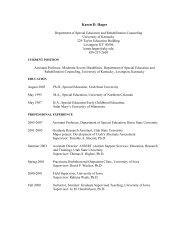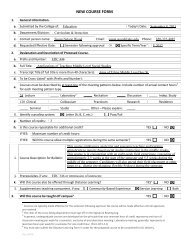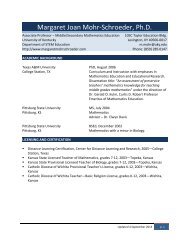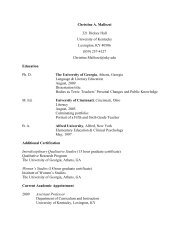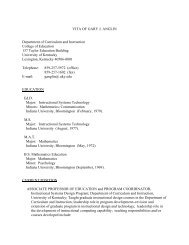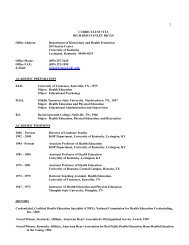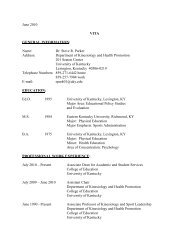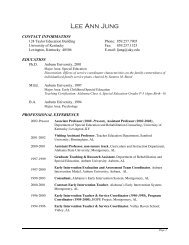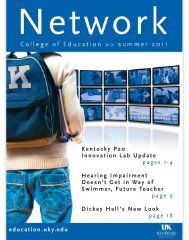Request for New Course (and Approval for Distance Learning)
Request for New Course (and Approval for Distance Learning)
Request for New Course (and Approval for Distance Learning)
You also want an ePaper? Increase the reach of your titles
YUMPU automatically turns print PDFs into web optimized ePapers that Google loves.
REQUEST FOR NEW COURSE1. General In<strong>for</strong>mation.a. Submitted byt~~Colle&e of: Education Today's[)at~: 11/30/09b. Department/Division: Educational Leadership Studiesc. Contact person name: Tricia Browne-Ferrigno Email:tricia.ferrigno@uky.eduPhone: 257-5504d. <strong>Request</strong>ed Effective Date: .[81 Semester foll~""in~apErC)\lal·· ORD?peCific Terrrl/'ft:arl :2. Designation <strong>and</strong> ~e~cription of Proposed <strong>Course</strong>.a. Prefix <strong>and</strong> Number: ELS 509b. Full Title: Technology Leadership in Schoolsc. TranscriptTitle (if full title is more than 40 characters):Technology Leadership in Schoolsd. To be Cross-Listed' with (Prefix <strong>and</strong> Number):e.Cou~sesmust be d~scribed byat least one of the meeting patterns below. Include numbe~ of actual conta~t h~~~s3<strong>for</strong> each meeting pattern type.Lecture __ Laboratory' Recitation Discussion __ Indep. StudyClinical __ Colloquium Practicum Research __ ResidencySeminarStudio1 hr weekly Other - Pleaseexplain:Hybrid (online, face-to-face)f. Identify a grading system: ~. Letter (A, B, C, etc.)~. Number of credits: 1h. Is this course repeatable <strong>for</strong> additional credit?IfVES: Maximum number of credit hours:..............................._.""'D Pass/FailYEsDNOt8jIfVES: Will this course allow multiple registrations during the same semester? VES D NO Di. <strong>Course</strong> Description <strong>for</strong> Bulletin:The In<strong>for</strong>mation Revolution fundamentally changed the way schools operate atthe beginning of the 21st century not only has technol()~y facilitated improved1<strong>Course</strong>s are typically made effective <strong>for</strong> the semester following approval. No course will be made effective until all approvalsare received.2 The chair of the cross-listing department must sign off on the Signature Routing Log.3 In general, undergraduate courses are developed on the principle that one semester hour of credit represents one hour ofclassroom meeting per week <strong>for</strong> a semester, exclusive of any laboratory meeting. laboratory meeting, generally, represents atleast two hours per week <strong>for</strong> a semester <strong>for</strong> one credit hour. (from SR 5.2.1)---_._._--_.._---
REQUEST FOR NEW COURSEschool operations, but also is radically changing how students learn inside <strong>and</strong>outside of the classroom. ElS 609 emphasizes the role of the teacher leader inimproving the school-wide technology integration <strong>and</strong> use of technology beyondthe classroom to link people <strong>and</strong> resources to integrate more innovation into theschool environment.j. Prereguisites, if any: . Nonek. Will this course also be offered through <strong>Distance</strong> <strong>Learning</strong>? YES 4 ~I. Supplementary teaching component, if any: D Community-Based ExperienceD Service <strong>Learning</strong>3. Will this course be taught off campus? YES0NO 0D Both..4. Frequency of <strong>Course</strong> Offering.a. <strong>Course</strong> will be offered (check all that apply):b. Will the course be offered every year?Fall~ SummerYES ~NO 0... If NO! ~xplain:5. Are facilities <strong>and</strong> personnel necessary <strong>for</strong> the proposed new course available? YES rgjNO 0If ~C?, explain:6. What enrollment (per section per semester)mayreas.o.l1.,!bIY~E:!~)(pE:!~ted? 15-207. Anticipated Student Dem<strong>and</strong>.a. Will this course serve students primarily within the de~ree program?b. Will it be of interest to a si~nificant number of students outside the degree pgm?If YES,explain: E1..5.609maybe taken.bxanyg~a.9uate student interested in topi~:YES ~YES ~NO DNO 08. Check the catE!~()r.,.most applicable to this course:D Traditional- Offered in Corresponding Departments at Universities Elsewhereo Relatively<strong>New</strong> - NowBeing\N'idely Established~_Not Y~uound in Many (or Any) OtherUniversities9. <strong>Course</strong>Relationship to Program(s).a. Is this course part of a proposed new program?If YES,name the propose~~ewpro~ram:b. Will this course be a new requirement" <strong>for</strong> ANY program?YESYES ~NO D.If YES s ,list affected programs:MEd in Educational LeadershipStudies10. In<strong>for</strong>mation to be Placed on Syllabus.a. Is the course 400G or 500? YES DNO4 You must also submit the <strong>Distance</strong> <strong>Learning</strong> Form in order <strong>for</strong> the proposed course to be considered <strong>for</strong> DL delivery.5 In order to change a program, a program change <strong>for</strong>m must also be submitted.
REQUEST FOR NEW COURSEIf YES,the differentiation <strong>for</strong> undergraduate <strong>and</strong> graduate students must be included in the in<strong>for</strong>mation required in10.b. You must include: (i) identification of additional assignments by the graduate students; <strong>and</strong>/or (ii)establishment of different grading criteria in the course <strong>for</strong> graduate students. (See SR 3.1.4.)b. DThe syllabus, including course description, student learning outcomes, <strong>and</strong> grading policies (<strong>and</strong> 400G-jSOOlevelgrading differentiation if applicable, from 10.a above) are attached.
REQUEST FOR NEW COURSEGeneralIn<strong>for</strong>mation:Signature Routing Log<strong>Course</strong> Prefix <strong>and</strong> Number: ElS 609Proposal Contact Person Name:Tricia Browne-FerrignoPhone: 257-5504Ernail: tricia.ferrigno@uky.eduINSTRUCTIONS:Identify the groups or individuals reviewing the proposal; note the date of approval; offer a contactperson <strong>for</strong> each entry; <strong>and</strong> obtain signature of person authorized to report approval.Internal College <strong>Approval</strong>s <strong>and</strong> <strong>Course</strong> Cross-listing <strong>Approval</strong>s:Reviewing GroupDate ApprovedContact Person (name/phone/email)EDL 11/10/09<strong>Course</strong>s & CurriculaCollege of EducationJU/3/D,rdlglo~Lars Bjork / 257-2450 / Ibjorl@uky.eduJ¢+f l2~se 7Jflfot ~ef(.(eestbfAk,.eJ~b~("h5/"f"" 7~fl1r;J5t.tol)Cj) IAky_eJ'f/ // /Externai-to-College<strong>Approval</strong>s:Council Date Approved Signature<strong>Approval</strong>Revlsion''ofUndergraduateCouncilGraduateCouncilHealth Care Colleges CouncilSenate Council <strong>Approval</strong> University Senate <strong>Approval</strong>Comments:theCouncilsthiscouncil.to indicate approval of revisions made subsequent to that council's approval, if deemed necessary by
ELS 609Technology LeadershipUniversity of Kentucky College of EducationResearch <strong>and</strong> Reflection <strong>for</strong> <strong>Learning</strong> <strong>and</strong> Leading<strong>Course</strong> SyllabusXXX Semester, XXX YearSection XXX(1 credit hour)Hybrid <strong>Course</strong> DeliveryPredominately independent study supplemented withonline activities, fieldwork, <strong>and</strong> five class sessionsXXX (day) XXX (time) PMUK Campus Location TBAContact In<strong>for</strong>mationInstructor:Justin Bathon, J.D./Ph.D.Office:111 Dickey HallE-mail address: justin.bathon@uky.eduOffice phone: (859) 257-7845Cell phone: (859 321-4203Office hours:By appointment (preferably made via e-mail)Virtual office hours: TBACampus address: Department of Educational Leadership Studies111 Dickey Hall, College of EducationUniversity of KentuckyLexington, KY 40506-0017Department phone: (859) 257-8921Department Web site: http://education.uky.edu/EDL/Personal Website: http://www.justinbathon.comBlog & <strong>Course</strong>ware: http://www.edjurist.comTwitter:http://www.twitter.com/edjuristSkype ID:jbathonELS 609 Technology Leadership Page 1
<strong>Course</strong> Description in UK BulletinThe In<strong>for</strong>mation Revolution fundamentally changed the way schools operate at the beginning ofthe 21 st century—not only has technology facilitated improved school operations, but also isradically changing how students learn inside <strong>and</strong> outside of the classroom. ELS 609 emphasizesthe role of the teacher leader in improving the school-wide technology integration <strong>and</strong> use oftechnology beyond the classroom to link people <strong>and</strong> resources to integrate more innovation intothe school environment.Major <strong>Course</strong> ObjectivesBillions of dollars are spent each year on technology <strong>for</strong> schools in the U.S. (Anderson & Dexter,2004). St<strong>and</strong>ards are published, such as the NETS-T (2008) <strong>and</strong> the NETS-A (2009), in anongoing ef<strong>for</strong>t to prioritize technology adoption. And, generally, institutions spend a great dealof ef<strong>for</strong>t speaking on the importance of technology. Yet, technology leaders are scarce. Theobjectives <strong>for</strong> this course are to leverage your leadership as a teacher to move schools towardinnovation. To do so, in this course you will learn about how our schools have changed <strong>and</strong> howthey must continue to change. You will learn about effective technology integration <strong>and</strong> studyexemplary cases. You will learn about technology tools that might be effective in buildingprofessional learning communities around technology. And, finally, you will build your ownpersonal learning network to advance your own learning once the class is finished.Required <strong>Course</strong> Textbook <strong>and</strong> ReadingsProfessional reading <strong>and</strong> reflection are fundamental components of this course; however, thiscourse does not require a textbook. Instead, readings (or viewing in the case of videos) arerequired <strong>for</strong> each learning period. The schedule contains in<strong>for</strong>mation on the required readings,many accessible from the World Wide Web, <strong>and</strong> required video viewing.Integration of Syllabus with UK College of Education Conceptual FrameworkThis graduate course addresses the four themes within the conceptual framework of the UKCollege of Education: research, reflection, learning, <strong>and</strong> leading. Throughout the semesterstudents have opportunities to review, analyze, discuss, <strong>and</strong> apply research from diverseperspectives in education, including professional scholarship <strong>and</strong> practitioner inquiry <strong>and</strong> reflecton their own practices as P-12 educators as they study, observe, <strong>and</strong> work in P-12 school <strong>and</strong>university classrooms. Reflection is integrated regularly through oral <strong>and</strong> written communicationto help students hone their analytical <strong>and</strong> problem-solving skills that comprise criticalprofessional reflection on one’s own practice. This course emphasizes the commitment of theUK College of Education to ensure that its graduates continue their professional careersequipped <strong>for</strong> life-long learning as educators actively leading colleagues in their schools,districts, <strong>and</strong> professional organizations. The ultimate goal in addressing these four themes is toproduce educational leaders who work together to improve student learning among diversepopulations <strong>and</strong> improve education in Kentucky <strong>and</strong> beyond.ELS 609 Technology Leadership Page 2
Commitment to DiversityUK is committed to making diversity central to university policies, decisions, <strong>and</strong> practices tostrengthen diversity within the Commonwealth. Ef<strong>for</strong>ts by a broad-based task <strong>for</strong>ce appointed byPresident Todd defined diversity asembracing difference or promoting increased knowledge regarding race/ethnicity, gender,religion, sexual orientation, disability, veteran affairs, <strong>and</strong> thought within an inclusivecommunity. This definition of diversity values an inclusive institutional culture, academicprograms, <strong>and</strong> co-curricular activities that prepare students <strong>for</strong> active, global citizenship.This commitment further allows <strong>for</strong> an educational process that fosters growth among allmembers of the academic community by including a wide array of talents, <strong>and</strong>recognizing the human differences are organizational strengths (University-WideComprehensive Diversity Plan Task Force Report, April 2005, p. 6).Because the desired outcome is excellence in education, UK “does not practice discrimination onthe basis of race/ethnicity, gender, religion, sexual orientation, or disability” (p. 6).The College of Education supports the university-wide definition of diversity <strong>and</strong> enhances itthrough an exp<strong>and</strong>ed interpretation. This broader conceptualization of diversity includes learningexceptionalities, native languages, socioeconomic status, <strong>and</strong> life experiences often created byresiding in unique geographical regions such as Appalachia. Curricula within the UK College ofEducation, field experiences, <strong>and</strong> membership of its faculty <strong>and</strong> student body reflect acommitment to diversity.Leading successful P-12 schools <strong>and</strong> districts requires underst<strong>and</strong>ing of <strong>and</strong> sensitivity todifferences among groups of people <strong>and</strong> individuals based on ethnicity, race, socioeconomicstatus, gender, exceptionalities, language, religion, sexual orientation, <strong>and</strong> geographical area.Hence, diversity is a theme woven throughout this graduate course, which focuses on preparing<strong>and</strong> developing principals <strong>and</strong> other educational leaders with requisite knowledge, dispositions,<strong>and</strong> skills to practice effectively the multiple responsibilities of school leadership <strong>and</strong> changeagency.UK PoliciesThe adopted UK academic policies apply in this course <strong>and</strong> are articulated in the Students Rights<strong>and</strong> Responsibilities H<strong>and</strong>book <strong>and</strong> the UK Graduate Bulletin. Important policies <strong>and</strong> regulationsapplicable to this course include, but are not limited to, those concerning attendance, cheating<strong>and</strong> plagiarism, course withdrawal, incomplete grades, <strong>and</strong> acceptable st<strong>and</strong>ards of English. Asthe instructor, I retain absolute discretion concerning acceptance of required assignments afterestablished due dates <strong>and</strong> reserve the right to lower grades on assignments submitted late.Absences. The University defines acceptable reasons <strong>for</strong> absences as (a) serious illness,(b) university-related trips, (c) major religious holidays, <strong>and</strong> (d) other circumstances thatthe instructor finds to be “reasonable cause <strong>for</strong> nonattendance.” Because the class meetsonly five times, regular attendance is essential. If students must miss a scheduled classmeeting, then they must notify me about the reason <strong>for</strong> the absence be<strong>for</strong>e it occurs. Inthe event of emergency absences (e.g., personal illness, major accident, death of familyELS 609 Technology Leadership Page 3
member), students should notify me as soon as possible, preferably through e-mailcommunication. Additional assignments may be required <strong>for</strong> missed class meetings.Canceled Class. If a class meeting must be canceled due to bad weather or otherun<strong>for</strong>eseen circumstances, I will make every possible ef<strong>for</strong>t to contact you in sufficienttime to avoid an unnecessary travel.Changes to Syllabus. I retain the right to modify this syllabus, if necessary, to meet thelearning objectives of this course. Changes to this syllabus will be discussed with you <strong>and</strong>provided in writing as an addendum distributed electronically via e-mail <strong>and</strong> posted onthe course Blackboard.Go to www.research.uky.edu/gs/bulletin/bullinfo.shtml <strong>for</strong> more in<strong>for</strong>mation about UK Policies.<strong>Distance</strong> <strong>Learning</strong> ConsiderationsThis course requires use of in<strong>for</strong>mation technology: Students are expected to have regular accessto a personal computer <strong>and</strong> the Internet to complete their learning activities. All Web-basedactivities are to be completed within designated sections of the course Blackboard, which can beaccessed through http://elearning.uky.edu.Teaching <strong>and</strong> Academic Support Services. Contact the UK Teaching <strong>and</strong> AcademicSupport Center <strong>for</strong> assistance via the Web (http://www.uky.edu/TASC/) or via telephone(859-257-8272).Procedures <strong>for</strong> Resolving Technological Problems. Contact the UK In<strong>for</strong>mationTechnology Customer Service Center via the Web (http://uky.edu/UKIT) or telephone(859-257-1300).In<strong>for</strong>mation on <strong>Distance</strong> <strong>Learning</strong> Library Services: The UK Library provides support<strong>for</strong> distance-learning students via the Web (www.uky.edu/Libraries/DLLS). You mayalso contact the DL Librarian, Carla Cantagallo, directly via electronic mail(dlservice@email.uky.edu) or telephone (859-257-0500 x 2171 or 800-828-0439).Document Delivery <strong>and</strong> Interlibrary Loan Services. Contact the UK Library to requestbook not at UK via http://www.uky.edu/Libraries/libpage.php?lweb_id=253&llib_id=16.Students with a Documented Disability. The UK Disability Resource Center(http://www.uky.edu/StudentAffairs/DisabilityResourceCenter/) provides support <strong>for</strong>those needing accommodations. Contact Jacob Karnes, Jr., Associate Dean of Students<strong>and</strong> Director of the Disability Resource Center, via e-mail (jkarnes@email.uky.edu) ortelephone (859-257-2754) if you have a documented disability that requires academicaccommodations in this course. The Center will require current disability documentation.When accommodations are approved, the Center will provide me a letter that details therecommended accommodations <strong>for</strong> you.Maximum Timeframe <strong>for</strong> Responding to Student Communications. Electronic mailaddressed to justin.bathon@uky.edu is the best method <strong>for</strong> communicating with me. Ishall make every ef<strong>for</strong>t to respond to electronic mail messages within 48 hours excludingELS 609 Technology Leadership Page 4
weekends or holidays or when the automatic reply is an out-of-office message. In case ofemergency, please call my office (859-257-7845) or the EDL office (859-257-8921).Collaboration with School PartnersIn accordance with requirements <strong>for</strong>m the Kentucky Education Professional St<strong>and</strong>ards Board(EPSB) to include partners, input from the Central Kentucky Educational Cooperative (CKEC),Fayette County Public Schools (FCPS) <strong>and</strong> the Southern Association of Colleges <strong>and</strong> Schools(SACS) personnel are involved in the design <strong>and</strong> delivery of this course.St<strong>and</strong>ards-based CurriculumELS 609 is an elective course <strong>for</strong> the MEd in Educational Leadership Studies designed to meetthe requirements established by the Kentucky Educational Professional St<strong>and</strong>ards Board (EPSB).Thus, course content is based on the Interstate School Leaders Licensure Consortium (ISLLC)St<strong>and</strong>ards <strong>for</strong> School Leaders adopted by Kentucky in 1998 <strong>and</strong> updated in 2008. 1 AlthoughELS 609 focuses specifically on technology leadership, the four central, recurring themes withinthe original st<strong>and</strong>ards provide a framework <strong>for</strong> teacher leadership including:• A Vision <strong>for</strong> Success• A Focus on Teaching <strong>and</strong> <strong>Learning</strong>• An Involvement of all Stakeholders• Demonstration of Ethical Behavior (Hessel & Holloway, 2002, p. 21) 2 .This course is also structured to align with these other professional st<strong>and</strong>ards:The advanced-level per<strong>for</strong>mance Kentucky Teacher St<strong>and</strong>ards (KTS) are integrated intocontent, assignments, <strong>and</strong> assessments as noted in Regulation 16 KAR 5:0101 Section 12 <strong>and</strong> themaster’s redesign guidelines as adopted by the EPSB in 2007. The complete list of st<strong>and</strong>ards <strong>and</strong>indicators are available at http://www.kyepsb.net/teacherprep/st<strong>and</strong>ards.asp. ELS 609 addressesthe following specific Kentucky Teacher St<strong>and</strong>ards: KTS 3 Create/Maintain <strong>Learning</strong> Climate,KTS 4 Implement/Manage Instruction, KTS 5 Assess/Communicate <strong>Learning</strong> Progress; KTS 7Reflect/Evaluate Teaching <strong>and</strong> <strong>Learning</strong>; KTS 8 Collaborate Others; KTS 9 EvaluateTeaching/Implement Professional Development; <strong>and</strong> KTS 10 Provide Leadership.The Kentucky Education Professional St<strong>and</strong>ards Board adopted the Interdisciplinary EarlyChildhood Education (IECE) <strong>New</strong> Teacher St<strong>and</strong>ards <strong>for</strong> Preparation <strong>and</strong> Certification:Interdisciplinary Early Childhood Education Birth to Primary <strong>and</strong> now requires use of the 2003revised version. The IECE st<strong>and</strong>ards are closely aligned with KTS <strong>and</strong> integrated as appropriateinto ELS 609 content, assignments, <strong>and</strong> assessments. A copy of the revised st<strong>and</strong>ards is availableat http://www.kyepsb.net/teacherprep/iecest<strong>and</strong>ards.aspThe International Society <strong>for</strong> Technology in Education (ISTE) has developed as set ofst<strong>and</strong>ards <strong>and</strong> per<strong>for</strong>mance indicators <strong>for</strong> administrators, teachers <strong>and</strong> students 3 . <strong>Course</strong>s in the1 Council of Chief State School Officers. (2008). Educational Leadership Policy St<strong>and</strong>ards: ISLLC 2008.Washington, DC: Author. Available at http://www.ccsso.org/publications/details.cfm?PublicationID=3652 Hessel, K. & Holloway, J. (2002). A framework <strong>for</strong> school leaders: Linking the ISLLC St<strong>and</strong>ards to practice.Princeton, NJ: Educational Testing Service.3 http://www.iste.org/AM/Template.cfm?Section=NETSELS 609 Technology Leadership Page 5
MEd in Educational Leadership Studies, however, focus specifically those <strong>for</strong> administrators as ameans to in<strong>for</strong>m <strong>and</strong> guide teachers when collaborating with their peers <strong>and</strong> principals to assureschool-wide student learning. The National Educational Technology St<strong>and</strong>ards <strong>for</strong>Administrators (NETS·A) are available athttp://www.iste.org/Content/NavigationMenu/NETS/ForAdministrators/2009St<strong>and</strong>ards/NETS-A_2009.pdfQuality of Student WorkUnless specified otherwise, all papers submitted to me must be presented in the writing style <strong>and</strong><strong>for</strong>mat described in the fifth edition of the Publication Manual of the American PsychologicalAssociation 4 , specifically those found on pages 296-320. All papers must be word-processed inTimes <strong>New</strong> Roman 12-point font. Students are expected to follow rules of usage <strong>and</strong> principlesof composition 5 . When the two resources listed in the footnote below present differing rules,students are to adhere to the academic writing guidelines in the APA Manual.Plagiarism. Where appropriate, references to professional <strong>and</strong> research literature need tobe integrated into the text <strong>and</strong> cited at the end of all papers. According to UK rules, theminimum consequence <strong>for</strong> cheating or plagiarism is an “E” in the course. Cheating orplagiarism is basically stealing ideas or intellectual property created by others. Studentsare cautioned to reference all resources properly: The mere re-phrasing of anotherauthor’s work does not excuse the student from the requirement <strong>for</strong> including propercitations. Cite all your sources accurately <strong>and</strong> appropriately! Be aware that re-cycling ofassignments from other courses can be interpreted as self-plagiarizing <strong>and</strong> fails to meetthe minimal st<strong>and</strong>ards of intellectual rigor required in graduate study.Late Submittals. Assignment due dates are provided in the course calendar on pages 7-8.Exceptions will only be made <strong>for</strong> extreme emergencies.Incomplete Grade. Incomplete grades <strong>for</strong> this course are issued reluctantly <strong>and</strong>sparingly. The UK Graduate School permits students one calendar year—unless ashorter time frame is determined mutually by the student <strong>and</strong> instructor—to removean “I” grade. If the contracted work is not completed satisfactorily, the “I” grade convertsautomatically to an “E” (a failing mark). UK <strong>and</strong> EDL rules require students requestingan “I” grade to complete a contract specifying how <strong>and</strong> when the “I” will be removedwithin the calendar year. The contract must be submitted to me be<strong>for</strong>e an “I” grade canbe issued. Incomplete work <strong>and</strong> missing assignments will be assigned “E” grades if thestudent does not submit a completed Incomplete Grade Contract by the course deadline.Student ResponsibilitiesGraduate students assume major responsibility <strong>for</strong> their own learning. As members of a learninggroup, they are likewise responsible <strong>for</strong> helping their peers by consulting with them <strong>and</strong>4American Psychological Association. (2001). Publication manual of the American Psychological Association (5thed.). Washington, DC: Author.5 Strunk, W., Jr., & White, E. B. (2000). The elements of style (4th ed.). <strong>New</strong> York: Longman.ELS 609 Technology Leadership Page 6
engaging in collaborative problem solving be<strong>for</strong>e seeking assistance from me. A class roster willbe posted in the course Blackboard site to encourage <strong>and</strong> support communication.RequirementsWith the exception of class participation, additional in<strong>for</strong>mation on all the course requirementswill be provided by the instructor. The following are a list of course requirements <strong>for</strong> whichpoints have been allocated <strong>and</strong> from which the final grade will be determined.1. Class Participation: Due to the course <strong>for</strong>mat, schedule <strong>and</strong> content, attendance isessential. Absences are reflected in a student’s grade. Students are required to attend allclasses, participate in discussions, interact with others in group work, <strong>and</strong> read theassigned material prior to each class.2. Technology Tool Show <strong>and</strong> Tell: Students will select a technology tool from a list orfind their own <strong>and</strong> review its purpose <strong>and</strong> operation. The students will both present thereview to the class in 5 min. or less <strong>and</strong> will write a short (1-2 page) review of the tool<strong>and</strong> its possible application to their school.3. Online Journal: Students will start a blog (space provided or students can select theirown) where they will post minimal weekly reflections on technology leadership issues.The journal will be judged on the quality of the reflection, not on the aesthetics.5. Build a Personal <strong>Learning</strong> Network: Students will be expected to show evidence ofhaving built <strong>and</strong> honed their own personal learning network. The personal learningnetwork can have both digital <strong>and</strong> paper components, but it should include a variety ofsources providing in<strong>for</strong>mation on a variety of sources important to all elements of yourfuture teacher leadership. Students will submit an overview of their personal learningnetwork (appox. 2-3 pages) with a list of the different elements <strong>and</strong> how they areadvancing your own personal learning.Grading Scale<strong>Course</strong> grades are based on a cumulative point total. The relative weighting <strong>for</strong> each of theseexpectations is presented in the matrix below.Class Assignments/Expectations Points Possible1. General Class Participation 202. Tech Show <strong>and</strong> Tell 403. Online Journal 404. Personal <strong>Learning</strong> Network 100Total Points 200Grades will be assigned according to the following scale: A=90-100 percentage points, B=80-89percentage points, C=70-79 percentage points, E=
ScheduleWeek Topics Readings Assignments Due1 SchoolsHave/MustChangeA Vision of K-12Students Today:http://www.youtube.com/watch?v=_A-ZVCjfWf8&feature=relatedOnline JournalDevelopmentLeadership <strong>for</strong> IT inSchools:http://www.springerlink.com/content/u134334517qj5q43/fulltext.pdf2 Envisioning<strong>and</strong>EvaluatingTechnologyIntegration3 TechnologyLeadershipCase Studies<strong>Learning</strong> to Change:http://www.youtube.com/watch?v=BHiby3m_RyMSara Dexter: QualityTechnology Support:What is it? Who hasit? And WhatDifference Does itMake?http://baywood.metapress.com/openurl.asp?genre=article&issn=0735-6331&volume=26&issue=3&spage=265TechnologyLeadership CaseStudieshttp://edtechcases.info/exemp_home.htm (detailson specific casesto watch/readprovided)Online JournalReflectionsOnline Journal Reflectionon Case StudiesELS 609 Technology Leadership Page 8
4 Sharing Networked Student:http://www.youtube.com/watch?v=XwM4ieFOotA&feature=relatedPersonal <strong>Learning</strong>Network (& Sharing)5 TechnologyLaw/Ethics/SafetyWill Richardson:Building a Personal<strong>Learning</strong> Network:http://www.youtube.com/watch?v=mghGV37TeK8David Quinn: LegalIssues in EducationalTechnology:Implications <strong>for</strong>School Leadershttp://eaq.sagepub.com/cgi/reprint/39/2/187Additional ResourcesChristensen, C. M., Horn, M. B. & Johnson, C. W. (2008). Disrupting class: How disruptiveinnovation will change the way the world learns. <strong>New</strong> York: Mc-Graw Hill.Collins, A. & Halverson, R. (2009). Rethinking education in the age of technology: The digitalrevolution <strong>and</strong> schooling in America. <strong>New</strong> York: Teachers College Press.Moe, T. M. & Chubb, J. E. (2009). Liberating learning: Technology, politics, <strong>and</strong> the future ofAmerican education. Jossey-Bass. Edison, NJ.Wagner, T. (2008). The global achievement gap: Why even our best schools don’t teach the newsurvival skills our children need – <strong>and</strong> what we can do about it. <strong>New</strong> York: Basic Books.Willingham, D. T. (2009). Why don’t students like school? A cognitive scientist answersquestions about how the mind works <strong>and</strong> what it means <strong>for</strong> the classroom. Edison, NJ:Jossey-Bass.ELS 609 Technology Leadership Page 9
<strong>Distance</strong> <strong>Learning</strong> FormThis <strong>for</strong>m must accompany every submission of a new/change course <strong>for</strong>m that requests distance learning delivery. This <strong>for</strong>mmay be required when changing a course already approved <strong>for</strong> DL delivery. All fields are required!Introduction/Definition: For the purposes ofthe Commission on Colleges Southern Association ofColleges <strong>and</strong> Schools accreditation review, distance learning is defined as a <strong>for</strong>mal educational processin which the majority of the instruction (interaction between students <strong>and</strong> instructors <strong>and</strong> amongstudents) in a course occurs when students <strong>and</strong> instructors are not in the same place. Instructionmay besynchronous or asynchronous. A distance learning (DL) course may employ correspondencestudy, oraudio, video, or computer technologies.A number of specific requirements are listed <strong>for</strong> DL courses. The department proposing the change indelivery method is responsible <strong>for</strong> ensuring that the requirements below are satisfied at the individualcourse level. It is the responsibility of the instructor to have read <strong>and</strong> understood the university-levelassurances regarding an equivalentexperience <strong>for</strong> students utilizing DL (available athttp://www.uky.edu/USC/<strong>New</strong>/<strong>for</strong>ms.htm).Error! Hyperlinkreference not valid.<strong>Course</strong> Number <strong>and</strong> Prefix: ElS 609 Date: November 10, 2009Instructor Email: justin.bathon@uky.eduInstructorName: Justin BathonCheck the method below that best reflects how the majority of course of the course content will be delivered.Internet/Web-based 0 Interactive Video 0 Hybrid IS]Curriculum<strong>and</strong> Instruction1. How does this course provide <strong>for</strong> timely <strong>and</strong> appropriate interaction between students <strong>and</strong> faculty <strong>and</strong> amongstudents? Does the course syllabus con<strong>for</strong>m to University Senate Syllabus Guidelines, specifically the <strong>Distance</strong><strong>Learning</strong> Considerations?The E1.S609 - Technology Leadership in Schools(see attached syllabus), con<strong>for</strong>ms to all University ofKentucky <strong>Distance</strong> <strong>Learning</strong> Syllabus Guidleines <strong>and</strong> specifically includes in<strong>for</strong>mationabout virtual office hours,procedures <strong>for</strong> resolving technical issues, notification <strong>and</strong> in<strong>for</strong>mation about self-disclosure <strong>and</strong> procedures <strong>for</strong>disability accommodationsetc. Web-based (Blackboard, Bb ) course delivery methods will be used <strong>for</strong> 60% ofindividual student engagment <strong>and</strong> course interactions (i.e.) 3 Bb <strong>and</strong> 2 Face-to-face seminars. Blackbboardassignments described in the syllabus include: (1) Asynchronous Dialogue: Students are required to interactwith their class peers or conduct a Web-based readiness self-assessment survey; (2) Class Participation:Students are expected to attend the class meetings, actively participate in discussions <strong>and</strong> activities, <strong>and</strong>complete independent work as presented on the course calendar <strong>and</strong>, (3) Personal <strong>Learning</strong> Network:Students will build an online personal learning network using tools such as twitter; (4) Online Journal: Studentswill keep an online journal using a blogging plat<strong>for</strong>m; (5) Tech Show <strong>and</strong> Tell: Students will find a usefultechnology tool <strong>and</strong> explain how that tool may be useful to others. Class <strong>and</strong> Blackboard (Bb) discussions areintended to facilitate critical thinking about their role as a professional educator <strong>and</strong> build their capacity toimprove her/his own learning. Discussion questions <strong>and</strong> asynchronous dialogue with other students in class onBlackboard will enhance critical thinking.Abbreviations: TAse::; Teaching <strong>and</strong> Academic Support Center DL" distance learning DLP" <strong>Distance</strong> <strong>Learning</strong> Programs
<strong>Distance</strong> <strong>Learning</strong> FormThis<strong>for</strong>m mustaccompanyeverysubmissionof a new/changecourse<strong>for</strong>m that requestsdistancelearningdelivery.This<strong>for</strong>mmayberequiredwhenchangingacoursealreadyapproved<strong>for</strong> DL delivery.All fieldsarerequired!2. How do you ensure that the experience <strong>for</strong> a DL student is comparable to that of a classroom-based student'sexperience? Aspects to explore: textbooks, course goals, assessment of student learning outcomes, etc.The course is designed as a hybrid that combines classroom-based <strong>and</strong> online (Web-based) learning <strong>and</strong>teaching <strong>for</strong>mats. The <strong>Distance</strong> <strong>Learning</strong> experience <strong>for</strong> students enrolled in this hybrid course is based on acohort model <strong>and</strong> will be comparable to classroom-based instruction.The web-based, Blackboard <strong>for</strong>mataligns with effective adult learning <strong>for</strong>mats <strong>and</strong> include timely access to the course instructor<strong>and</strong> peers as wellas feedback on reflections <strong>and</strong> assesssment of asignments. The syllabus clearly explicates students' readingassignments including required textbook(s), research-based journal articles <strong>and</strong> book chapters. All assigmentsare aligned with stated course objectives (goals). Instructor-student interaction is comparable to classroominstructional methods. Student per<strong>for</strong>mance is assessed by the instructor by through participation in <strong>and</strong>monitoring of asynchronus, on-line interactions, observations of in-class discussions, feedback on IndividualReflections (on-line), evaluation of Reflection Papers (see syllabus). A course requirement includes completingan On-Line Video Review of PLC'sto ensure all students have adequate background knowledge.3. How is the integrity of student work ensured? Please speak to aspects such as password-protected courseportals, proctors <strong>for</strong> exams at interactive video sites; academic offense policy; etc.This hybrid course (online <strong>and</strong> classroom-based) course will use University of Kentucky Blackboard systemtechnology protects the integrity of studentwork by employing a password protected course portal. The coursewill not require the use of examination proctors or other support staff or interactive video. The syllabusdescibes UK academic policies that apply in this course <strong>and</strong> are articulated in the "Students Rights <strong>and</strong>Responsibilities H<strong>and</strong>book" <strong>and</strong> "the UK Graduate Bulletin." Important policies <strong>and</strong> regulations applicable tothis course are explicitly stated in the syllabus including attendance, cheating <strong>and</strong> plagiarism, coursewithdrawal, incomplete grades, <strong>and</strong> acceptable st<strong>and</strong>ards of English, absences, cancelled classes, changes inthe syllabus, st<strong>and</strong>ards <strong>for</strong> assessing the quality of student work <strong>and</strong> late submittals. A statement of studentresponsibilities is incuded (see syllabus).4. Will offering this course via DL result in at least 25% or at least 50%* (based on total credit hours required <strong>for</strong>completion)Yes.of a degree program being offered via any <strong>for</strong>m of DL, as defined above?If yes, which percentage, <strong>and</strong> which program(s)?100% of the proposed Masters of Education in Educational Leadership Studies curricula will be available via<strong>Distance</strong> <strong>Learning</strong>.*As a general rule, if approval of a course<strong>for</strong> DL delivery results in 50% or more of a program being delivered through DL,the effective date of the course's DL delivery will be six months from the date of approval.5. How are students taking the course via DL assured of equivalent access to student services, similar to that of astudent taking the class in a traditional classroom setting?All students in this hybrid, DL course have equal access to all student services at the University ofKentucky <strong>for</strong> which they qualify <strong>and</strong> those studentservices are similar to those available to individualsAbbreviations: Ti\SC::: Teaching <strong>and</strong> Academic Support Center DL = distance iearning DLP = <strong>Distance</strong> Leaming Programs
<strong>Distance</strong> <strong>Learning</strong> FormThis <strong>for</strong>m must accompany every submission of a new/change course <strong>for</strong>m that requests distance learning delivery. This <strong>for</strong>mmay be required when changing a course already approved <strong>for</strong> DL delivery. All fields are required!taking this class in a tradition (i.e. face -to-face) classroom setting. Access to student services areexplicated on the University of Kentucky websites including but not limited to:(http://www.uky.edu.TASC/index.php) <strong>and</strong> (http://www.uky.edu/UKIT/).students who have specialneeds or require accomodations of any kind will be advised to register with the UK Disability ResourceCenter <strong>for</strong> assistance. The course instructor will work wit students on an individual basis to makeapproriate accommodations to participate in the clas <strong>and</strong> complete work (see syllabus).Library <strong>and</strong> <strong>Learning</strong> Resources6. How do course requirements ensure that students make appropriate use of learning resources?In addition to purchasing required textbooks, selected readings will be available through the University ofKentucky Libraries online reserve system or posted on the course Blackboard Website. Additionally, anymaterials that may pose problems <strong>for</strong> students with limited b<strong>and</strong>width access to online resources (e.g. digitalvideo classroom episodes <strong>for</strong> analysis) will be available via CD or DVD that can be mailed in that <strong>for</strong>mat tocourse participants upon request.7. Please explain specifically how access is provided to laboratories, facilities, <strong>and</strong> equipment appropriate to thecourse or program.Access is provided via students' personal computer proxy acess to online library resources (see syllabus).Student Services8. How are students in<strong>for</strong>med of procedures <strong>for</strong> resolving technical complaints? Does the syllabus list the entitiesavailable to offer technical help with the delivery <strong>and</strong>/or receipt of the course, such as the Teaching <strong>and</strong>Academic Support Center (http://www.uky.edu/TASC/index.php) <strong>and</strong> the In<strong>for</strong>mation Technology CustomerService Center(http://www.uky.edu/UKITD?Students are in<strong>for</strong>med of the availability of University of Kentucky services in the syllabus (TASC, Blackboard(Bb) help desk,UK IT Customer Service Center as described in the syllabus. Bb instructors have receivedrequired training in the use of the <strong>Course</strong> management System, UK Libraries online resources (<strong>and</strong> EZ Proxytools) <strong>and</strong> will assist students as needed. As a hybrid course offering, the classroom instruction will also includeAbbreviations: Ti\SC = Teaching <strong>and</strong> Academic SUPPO(i:Center DL = distance """ I H' '6 DLP := <strong>Distance</strong> <strong>Learning</strong> Programs
This <strong>for</strong>m must accompany ~may be required<strong>Distance</strong> <strong>Learning</strong> Formsubmission of a new/change course <strong>for</strong>m that requests distance learning delivery. This <strong>for</strong>mwhen changing a course already approved <strong>for</strong> DL delivery. All fields are required I8. How are students in<strong>for</strong>med of procedures <strong>for</strong> resolving technical complaints? Does the syllabus list the entitiesavailable to offer technical help with the delivery <strong>and</strong>/or receipt of the course, such as the Teaching <strong>and</strong>Academic Support Center (http://www.uky.edu!TASC/index.php) <strong>and</strong> the In<strong>for</strong>mation Technology CustomerService Center (http://www.uky.edu/UKITf}?Students are in<strong>for</strong>med of the availability of University of Kentucky services in the syllabus (TASC,Blackboard(Bb) help desk.Uk IT Customer Service Center as described in the syllabus. Bb instructors have receivedrequired training in the use of the <strong>Course</strong> management System, UK Libraries online resources (<strong>and</strong> EZ Proxytools) <strong>and</strong>.will assist students as needed. As a hybrid course offering, the classroom instruction will also includeoverviews <strong>and</strong> demostrations (<strong>and</strong> instruction as needed) in the use of all online course tools, resources <strong>and</strong>componets. In sum,all students in this course have equal access to all student services at the University ofKentucky <strong>for</strong> which they qualify. Access to student services are explicated on the University of Kentuckywebsites including but not limited to: (http://www.uky.edu.TASC/index.php) <strong>and</strong> (http://www.uky.edu/UKIT/)(see syllabus).9. Will the course be delivered via services available through the Teaching <strong>and</strong> Academic Support Center?YesNorgjDIf no, explain how students enrolled in DL courses are able to use the technology employed, as well as howstudents will be provided with assistance in using said technology.10. Does the syllabus contain all the required components, below? ~ YesD Instructor's virtual office hours, if any.D The technological requirements <strong>for</strong> the course.D Contact in<strong>for</strong>mation <strong>for</strong> TASC(http://www.uky.edu/TASC/; 859-257-8272) <strong>and</strong> In<strong>for</strong>mation TechnologyCustomer Service Center (http://www.uky.edu/UKIT/; 859-257-1300).DProcedure <strong>for</strong> resolving technical complaints.D Preferred method <strong>for</strong> reaching instructor, e.g. email, phone, text message.D Maximum timeframe <strong>for</strong> responding to student communications.D Language pertaining academic accommodations:o "If you have a documented disability that requires academic accommodations in this course,please make your request to the University Disability Resource Center. The Center will requirecurrent disability documentation. When accommodations are approved, the Center will provideme with a Letter of Accommodation which details the recommended accommodations. Contactthe Disability Resource Center, Jake Karnes, Director at 859-257-2754 or jkarnes@email.uky.edu."D In<strong>for</strong>mation on <strong>Distance</strong> <strong>Learning</strong> Library Services (http://www.uky.edu/Libraries/DLLS)oCarla Cantagallo, DL Librariano Local phone number: 859257-0500, ext. 2171; long-distance phone number: (800) 828-0439o(option #6)Email: dllservice@email.uky.eduo DL Interlibrary Loan Service: http://www.uky.edu/Libraries/libpage.php?Iweb id=253&llib id:::1611. I, the instructor of record, have read a,~ndrnderstood all of the ~rsity-Ievel statements regarding Dl.Instructor Name: Dr. Justin Bathon .s;;[) "2-. £.6(1:. .." - - / Instructor ~ignat"re:n./'/""7") :-.. •••



